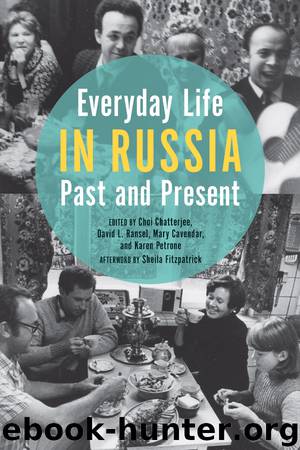Everyday Life in Russia by Choi Chatterjee

Author:Choi Chatterjee
Language: eng
Format: epub
Publisher: Indiana University Press
Published: 2014-03-20T16:00:00+00:00
CONTINUITY OR CHANGE?
Thus, even as specialists conducted their modernist campaign against show, sham, accumulated clutter, and commodity fetishism in the name of the communist way of life, the material equipment for display was designed, produced, and consumed. The glazed contemporary-style cabinet or sideboard became an almost ubiquitous item of furniture in the zal of the separate apartment, an essential piece of equipment for making home and maintaining order there, and a “normal” expectation and attribute of decent, cultured living. Domestic production was swelled by imports, introducing to the Soviet Union furnishing types established for bourgeois consumption in interwar Germany and Czechoslovakia. Imports accounted for a number of those in the interiors examined in this study, especially those in St. Petersburg. Furniture from the Baltic Republics was also desirable.
In their classic study The Meaning of Things (1981), Mihaly Csikszentmihalyi and Eugene Rochberg-Halton found that furniture was one of the categories of domestic things that their Chicago informants most frequently cited as “special.” The reasons they gave for this status associated furniture with memory value: roots, settledness, and stability.47 Continuity with the past was the charge leveled against the bufet by Soviet reformers, first in the 1920s and again in the Khrushchev era. This had more to do with the practices and aspirations it represented than with the survival of a particular example of the category. It is true that in regard to the contents, the harbored bufety may also have represented constancy, permanence, and settledness to their owners (as positive values rather than as regrettable vestiges of a bourgeois past that should have been rooted out) since they protected precious and fragile things such as fine glassware or china from damage. A number of my informants’ cabinets contained prerevolutionary Lomonosov or Kuznetsov services or the last remaining pieces of former sets, sometimes heirlooms and markers of their families’ former propertied, upper-middle-class status before the Revolution. Thus the cabinets represent an alternative identity from the Soviet ones they had lived (a fairy tale of hidden nobility, princesses disguised as paupers). Galina tells of her grandmother’s porcelain and art nouveau objets d’art.48 Some informants indicated the significance of complete sets, suites, or services that had survived, which they say counted as luxury or prestigious possessions.49
However, in regard to the 1960s cabinet installed in khrushchevki, we should question whether this item of furniture represented continuity and memory or, on the contrary, change: a new way of life and a new role for the “private” interior in the construction of identity associated with the development of a Soviet form of modern consumer society. As far as the production and availability of cabinets is concerned, this was a new departure rather than a continuation of established practice. The fact that a new type of cupboard to fit the dimensions and aesthetics of the new apartments was designed and manufactured is significant, for in the planned economy the odds were stacked against innovation.50 Production of the contemporary-style cabinet, as of other new products, required new state standards
Download
This site does not store any files on its server. We only index and link to content provided by other sites. Please contact the content providers to delete copyright contents if any and email us, we'll remove relevant links or contents immediately.
| Africa | Americas |
| Arctic & Antarctica | Asia |
| Australia & Oceania | Europe |
| Middle East | Russia |
| United States | World |
| Ancient Civilizations | Military |
| Historical Study & Educational Resources |
Red Famine: Stalin's War on Ukraine by Anne Applebaum(2816)
Chernobyl by Serhii Plokhy(2436)
Midnight in Chernobyl by Adam Higginbotham(2389)
The House of Government by Slezkine Yuri(2103)
Midnight in Chernobyl: The Untold Story of the World's Greatest Nuclear Disaster by Adam Higginbotham(2078)
Red Shambhala by Andrei Znamenski(2071)
The Gulag Archipelago (Vintage Classics) by Aleksandr Solzhenitsyn(1983)
All the Kremlin's Men by Mikhail Zygar(1961)
From Cold War to Hot Peace by Michael McFaul(1939)
Red Notice by Bill Browder(1927)
Putin's Labyrinth(1901)
The Future Is History by Masha Gessen(1820)
From Russia with Lunch by David Smiedt(1795)
A People's Tragedy by Orlando Figes(1766)
The Romanovs by Simon Sebag Montefiore(1722)
How to Tame a Fox (and Build a Dog): Visionary Scientists and a Siberian Tale of Jump-Started Evolution by Lee Alan Dugatkin & Lyudmila Trut(1680)
Putin's Labyrinth: Spies, Murder, and the Dark Heart of the New Russia(1664)
The Lost Spy by Andrew Meier(1634)
Art and Revolution by John Berger(1607)
